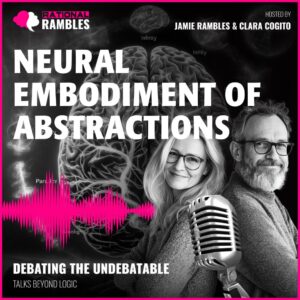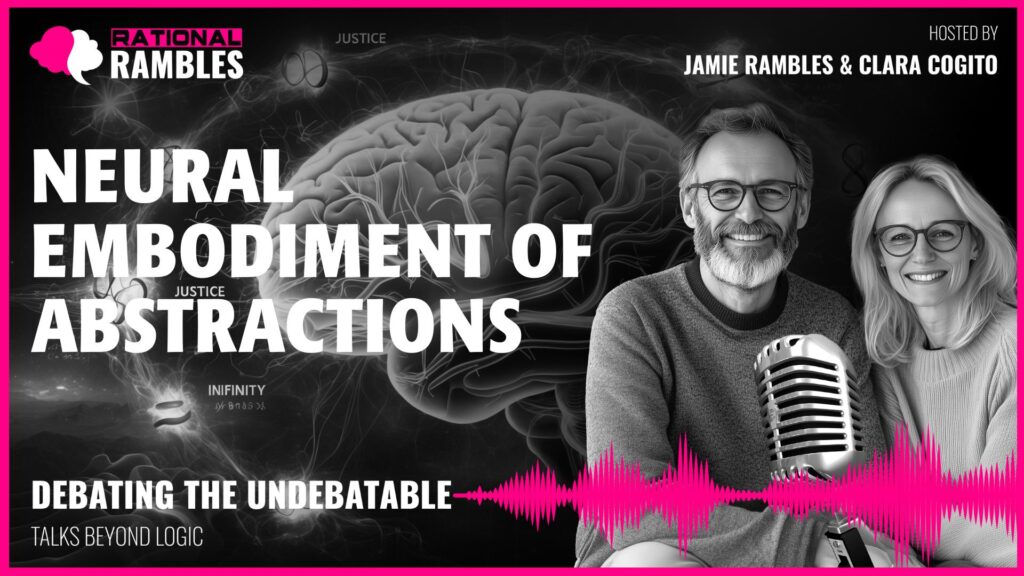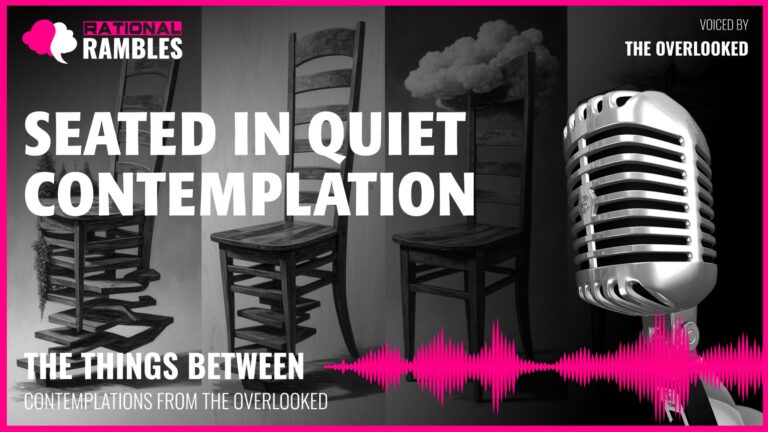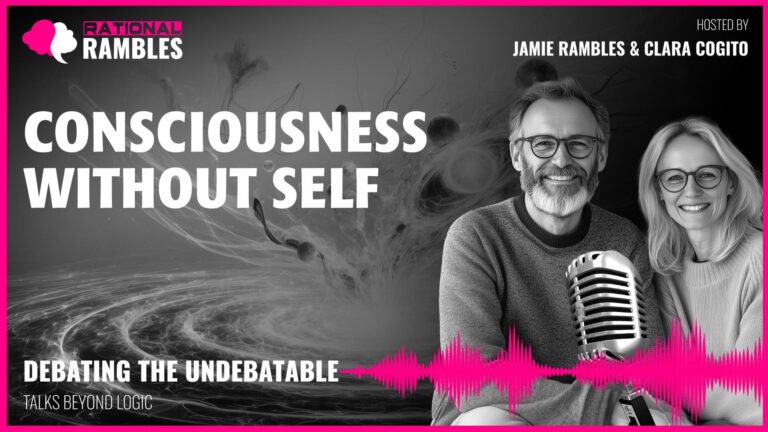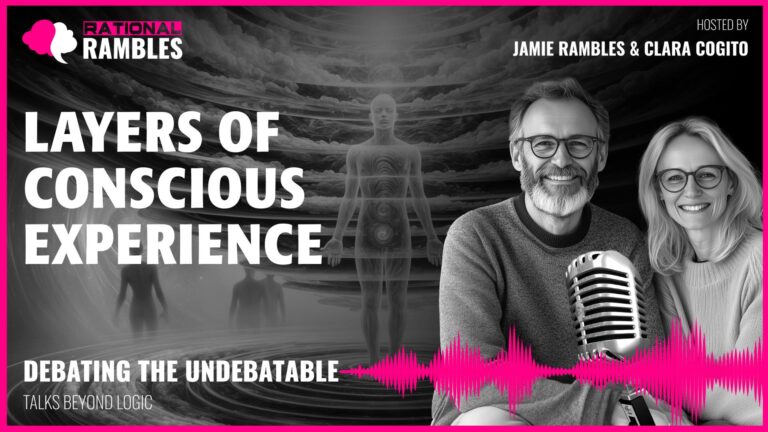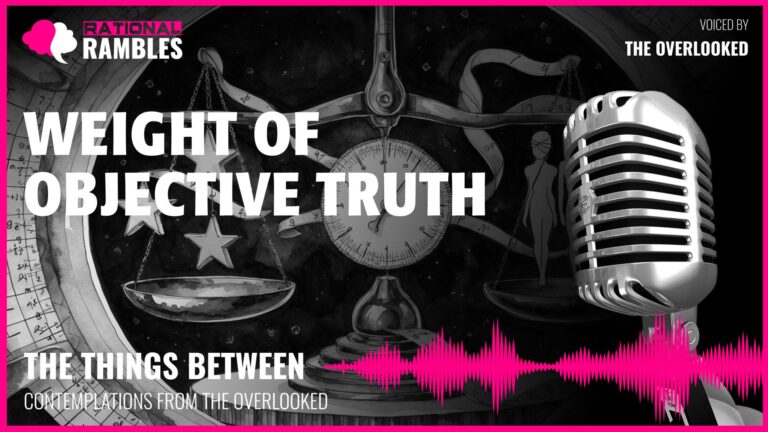Neural Embodiment of Abstractions: How Our Brains Might Intrinsically Encode Philosophical Concepts
Introduction: The Neural Foundations of Abstract Thought
At the intersection of neuroscience and philosophy lies a profound and provocative question: What if abstract concepts like justice, infinity, or paradox aren’t merely mental constructs developed through culture and experience, but rather have direct neurobiological correlates? This revolutionary hypothesis suggests that specific brain states might not just represent these concepts but somehow embody them—that our neural architecture inherently shapes and enables abstract thought in ways we’re only beginning to understand.
Traditionally, we’ve conceived of abstract concepts as emerging from more basic cognitive processes—pattern recognition, language acquisition, memory consolidation, and logical reasoning. However, mounting evidence from cognitive neuroscience, developmental psychology, and philosophical phenomenology suggests a more complex and intriguing relationship between our neural architecture and abstract thought. Perhaps certain abstractions are fundamental to our neural organization—built-in cognitive primitives that our brains naturally form or access, much like the specialized circuits we know exist for processing faces or detecting movement.
This perspective invites us to reconsider the nature of philosophical insight, the basis of conceptual disagreements, and even the ontological status of abstract concepts themselves. If justice or infinity have specific neural signatures, what does this tell us about their existence beyond our minds? How might such embodiment shape philosophical education, cross-cultural understanding, and the development of artificial intelligence? The implications extend across disciplinary boundaries, challenging long-held assumptions about the relationship between mind, brain, and reality.
Philosophical Precedents: Intuitions Without Modern Vocabulary
While the neurobiological embodiment of abstract concepts represents a contemporary hypothesis enabled by modern neuroscience, philosophers throughout history have intuited aspects of this relationship without the benefit of today’s scientific vocabulary. Immanuel Kant’s transcendental categories offer a striking historical parallel to this modern hypothesis.
Kant’s Transcendental Categories as Neural Architecture
Kant proposed that certain concepts—like causality, unity, plurality, and necessity—are not derived from experience but rather serve as preconditions for having coherent experiences at all. These categories, according to Kant, are built into our cognitive apparatus, structuring all possible experience. In modern terms, we might interpret Kant as intuiting something profound about our neural organization: that certain abstract concepts reflect the fundamental architecture of our brains rather than merely being learned from our interactions with the world.
This interpretation suggests that Kant’s transcendental idealism—often considered highly abstract and divorced from physical reality—might actually represent an early insight into the neurobiological basis of cognition. If certain abstract concepts are indeed neurobiologically embodied, then Kant’s insistence that these concepts shape all possible human experience takes on new significance as a prescient recognition of the brain’s role in structuring thought.
Plato’s Forms and Neurobiological Realism
Even earlier, Plato’s theory of Forms proposed that abstract concepts like Justice or Beauty exist in a realm beyond physical reality, with our earthly experiences representing mere shadows of these perfect forms. While modern neuroscience would reject the metaphysical dualism inherent in Plato’s view, the core intuition that abstract concepts have a reality that transcends particular instances resonates with the hypothesis of neurobiological embodiment.
If concepts like justice have specific neural signatures that are consistent across individuals (albeit with cultural variations), this would suggest that these concepts have a kind of reality beyond cultural convention—not in a separate metaphysical realm as Plato proposed, but grounded in the common neural architecture of human brains. This perspective offers a naturalistic reinterpretation of Platonic realism, suggesting that Forms might exist not in a separate realm but as consistent patterns of organization in the physical brain.
Aristotle’s Middle Path: Universals in Particulars
Aristotle’s view that universals exist, but only as instantiated in particulars, offers perhaps the closest classical parallel to the neurobiological embodiment hypothesis. For Aristotle, the concept of “circle” doesn’t exist independently of particular circles, yet it represents something real that all circles share. Similarly, justice doesn’t exist independently of particular just actions, yet it captures something essential about what makes those actions just.
This Aristotelian perspective aligns with the idea that abstract concepts have neural embodiments that emerge from but cannot be reduced to their instantiation in individual brains. Just as Aristotle saw universals as patterns that exist within particulars rather than beyond them, we might understand abstract concepts as patterns that emerge from neural activity rather than existing independently of it. This avoids both the excessive realism of Platonism and the reductionism that would deny abstract concepts any reality beyond convention.
Neurobiological Primitives and Cultural Elaboration
If abstract concepts are neurobiologically embodied, how do we account for the vast cultural variations in how these concepts are understood and expressed? The evidence suggests a complex interplay between innate neural capacities and cultural shaping—between what we might call “neurobiological primitives” and their cultural elaboration.
The Fairness Detection System: A Case Study
Research on moral development provides compelling evidence for the existence of neurobiological primitives related to abstract concepts like fairness and justice. Studies show that even very young infants (as young as 3-6 months) demonstrate surprise when witnessing unfair distributions of resources, suggesting an innate capacity to detect and respond to unfairness. Similar capacities have been observed in non-human primates, further suggesting that these represent evolved neural mechanisms rather than purely cultural constructions.
This innate fairness detection system appears to function as a neurobiological primitive—a basic capacity built into our neural architecture that later gets elaborated into more complex and culturally specific conceptions of justice. The primitive provides the foundation, while culture builds the specific structure atop that foundation. This helps explain why notions of fairness and justice appear universal across human societies, yet take dramatically different forms in different cultural contexts.
Language and the Chomskian Parallel
This relationship between neurobiological primitives and cultural elaboration parallels Noam Chomsky’s theory of universal grammar in linguistics. Chomsky proposed that humans possess innate linguistic capacities—neurally encoded rules and structures that make language acquisition possible—which then get expressed differently in different languages. No two languages are identical, yet all human languages follow certain universal principles because they all develop within the constraints of our common neural architecture.
In a similar way, abstract concepts like justice might be grounded in universal neural capacities that get expressed differently across cultures. The capacity to detect fairness provides the neural substrate, while cultural factors determine how that capacity develops into specific conceptions of justice—whether emphasizing equality, merit, need, or other distributive principles. This explains both the universal presence of justice concepts across cultures and their significant variation.
Cultural Neuroscience: How Culture Shapes Neural Organization
The relationship between neural architecture and culture is not unidirectional but reciprocal. Growing research in cultural neuroscience demonstrates that cultural practices and experiences can shape neural development in profound ways. For example, studies have found that East Asian participants show different patterns of visual processing compared to Western participants, reflecting cultural differences in attention to context versus focal objects.
If abstract concepts are neurobiologically embodied, we should expect substantial cultural variation in how they’re instantiated. Different cultural contexts may promote different patterns of neural organization for the same abstract concepts. This doesn’t mean these concepts are merely cultural constructs with no neurobiological basis; rather, it suggests that culture shapes how our neurobiological capacities develop and express themselves.
This perspective helps resolve the apparent tension between the universality and diversity of abstract concepts across cultures. The neurobiological primitives provide common ground, while cultural practices shape how these primitives develop into specific neural configurations. The result is a complex interplay where abstract concepts are neither purely innate nor purely constructed, but emerge from the interaction between our neural architecture and our cultural environment.
The Phenomenology of Abstract Thought
One of the most compelling aspects of the neurobiological embodiment hypothesis is its potential to explain the distinctive phenomenology of abstract thought—the subjective experience of understanding abstract concepts. This phenomenology often involves more than just knowing definitions or logical relationships; it includes a sense of direct apprehension or “grasping” that has puzzled philosophers for centuries.
The “Aha Moment” of Conceptual Understanding
Anyone who has struggled with a difficult abstract concept—whether in philosophy, mathematics, or another field—has likely experienced the sudden “aha moment” when understanding finally clicks into place. This experience has a distinctive phenomenological quality: it feels less like accumulating information and more like achieving a new perspective that makes the concept directly accessible. The concept seems to snap into focus, often accompanied by a feeling of clarity and even aesthetic appreciation.
From a neurobiological perspective, these moments correlate with specific bursts of neural activity, particularly in the right anterior superior temporal gyrus and other regions associated with insight. If abstract concepts involve specific neural configurations, then the “aha moment” might represent the brain finally achieving that configuration—like a key turning in a lock or a puzzle piece finding its place. This would explain why conceptual understanding often feels like a discontinuous leap rather than a gradual accumulation.
Direct Experience vs. Intellectual Knowledge
Philosophers and mathematicians often report experiencing abstract concepts in ways that go beyond merely thinking about them. Mathematicians describe “seeing” or “feeling” mathematical relationships rather than just knowing them intellectually. Philosophers similarly report a kind of direct access to concepts like justice or beauty that transcends verbal definition.
If these abstract concepts are neurobiologically embodied, such reports make perfect sense. Understanding justice wouldn’t just involve knowing facts about justice or being able to define it verbally, but actually experiencing a specific neural state—a state that feels as real and immediate as seeing the color red or feeling pain. The phenomenology wouldn’t be metaphorical but would reflect the actual neural embodiment of the concept.
Emotional Components of Abstract Understanding
The phenomenology of abstract thought often includes emotional dimensions that traditional accounts struggle to explain. Philosophical insights can trigger profound emotional responses—awe, wonder, even existential anxiety. Mathematical beauty can evoke aesthetic appreciation similar to that experienced in art or music. These emotional components don’t seem incidental to understanding but integral to it.
Contemporary affective neuroscience increasingly shows that emotion and cognition are deeply integrated, not separate systems. If abstract concepts are neurobiologically embodied, their neural patterns likely include regions involved in emotional processing. The emotional response to injustice wouldn’t be merely a reaction to understanding justice but part of what constitutes our neural embodiment of justice itself.
This integration explains why philosophical contemplation can be so emotionally affecting. When we achieve a new insight into an abstract concept like freedom or beauty, the emotional response isn’t just a reaction to the insight but part of the neural configuration that constitutes the insight itself. The concept is experienced through an integrated cognitive-emotional state, not merely understood intellectually.
Philosophical Disagreement in a Neurodiverse World
If abstract concepts are neurobiologically embodied, philosophical disagreements take on a fascinating new dimension. Perhaps some philosophical disputes stem not just from different beliefs or values but from subtle neurological differences between individuals—differences in how abstract concepts are physically instantiated in their brains.
Neural Diversity and Philosophical Intuitions
Philosophers have long noted that intuitions about thought experiments can vary dramatically between individuals and across cultures. The trolley problem, Chinese room argument, and other philosophical scenarios often elicit divergent intuitive responses that seem resistant to resolution through argument alone. If these intuitions reflect different patterns of neural organization for abstract concepts like moral responsibility or consciousness, such resistance makes perfect sense.
Research on moral foundations theory provides supporting evidence for this view. Studies show that conservatives and liberals display different patterns of brain activation when making moral judgments, with conservatives showing greater sensitivity to purity/sanctity violations and liberals to harm/fairness violations. These aren’t just different belief systems but different ways of neurally processing moral information.
This neural diversity suggests that some philosophical disagreements might not be resolvable through argument alone, as they reflect different ways of neurally embodying the concepts under discussion. It’s not that one side is “right” and one is “wrong”—they may be operating with fundamentally different neural organizations that structure their conceptual understanding in divergent ways.
Dynamic Models: Attractor States and Neural Plasticity
While neural differences certainly exist, the brain also shows remarkable plasticity. People can and do change their minds on philosophical and moral questions. If abstract concepts were rigidly encoded in neural architecture, such changes would be nearly impossible. This suggests we need a more dynamic model of neurobiological embodiment.
Abstract concepts might be better understood not as fixed neural patterns but as attractor states in neural dynamics—configurations that neural activity naturally falls into but which can be reshaped through experience and reflection. These attractor states would represent stable patterns of neural firing that become more probable over time through reinforcement but remain susceptible to reorganization under appropriate conditions.
This dynamic model preserves both the idea of neurobiological embodiment and the reality of philosophical growth and change. It also aligns with recent work in predictive processing frameworks, where the brain is constantly generating predictions based on prior experience and adjusting to errors. Abstract concepts might emerge as stable patterns in this predictive machinery, patterns that can be revised through exposure to new evidence or perspectives.
Implications for Philosophical Methodology
Understanding philosophical disagreement in terms of neural diversity has important implications for philosophical methodology. If different philosophical traditions have developed techniques that work better for different neural organizations, this would explain why some individuals resonate more with analytical philosophy while others find phenomenology or Eastern philosophical traditions more compelling.
Some traditions emphasize logical analysis, others use meditation or contemplation, still others rely on dialogue or storytelling. These different approaches might be activating different neural pathways to reach similar conceptual terrain. Individuals might find certain approaches more effective based on their particular neural organization.
This suggests that philosophical education should be personalized, recognizing that different minds might need different pathways to grasp the same abstract concept. It also suggests that philosophical progress might require integrating insights from multiple methodological traditions rather than expecting a single approach to yield universal agreement.
The Ontology of Abstract Concepts
If abstract concepts have neural correlates, what does that tell us about their ontological status? Does “justice” or “infinity” exist in some sense beyond their instantiation in our brains? Or are they entirely constituted by these neural patterns? This question intersects with age-old philosophical debates about the nature of universals and concepts.
Beyond Reductionism: Multiple Levels of Reality
A crude reductionism would claim that justice is “nothing but” neural pattern X—that the concept can be completely reduced to its physical instantiation. This view faces significant challenges, however, as it struggles to account for the consistent features of concepts across different brains and cultures. If justice were nothing but a neural pattern, and neural patterns vary between individuals, how do we explain the shared understanding that makes communication about justice possible?
A more sophisticated view recognizes that abstract concepts can be realized through neural patterns without being identical to them. This parallels how a symphony is realized through sound waves without being nothing but sound waves. The symphony has properties (structure, emotional qualities, aesthetic features) that cannot be reduced to the physical properties of sound waves, yet it only exists through physical instantiation in sound waves.
Similarly, justice might have properties that cannot be reduced to the physical properties of neural patterns, yet it only exists through instantiation in neural patterns. This view acknowledges both the physical basis of abstract concepts and their irreducibility to that physical basis.
Emerging Patterns: The Musical Performance Analogy
The relationship between abstract concepts and their neural embodiments might be usefully compared to the relationship between a musical composition and its performance. The composition isn’t reducible to any particular performance, yet it only exists through performances. Different performances of the same composition might vary substantially while still being recognizable as the same work.
Similarly, justice might not be reducible to any particular neural embodiment, yet it only exists through such embodiments. Different neural embodiments of justice across individuals or cultures might vary substantially while still being recognizable as embodiments of the same concept. The concept has an identity that transcends any particular instantiation while depending on instantiation for its existence.
This analogy preserves both the reality of abstract concepts and their dependence on physical instantiation. It also allows for multiple valid “performances” of the same concept across different brains or even potentially across different types of systems capable of the relevant kind of organization.
Collective Emergence and Social Reality
Abstract concepts like justice might also be understood as emerging from networks of brains in social interaction without being reducible to any single brain state. Just as wetness is a property that emerges from water molecules but isn’t present in any single molecule, concepts like justice might emerge from collective neural activity without being present in any single neural pattern.
This perspective aligns with theories of social ontology that recognize the reality of social facts while grounding them in physical interactions. Money, for example, has real causal powers despite depending entirely on collective agreement for its existence. Abstract concepts might similarly have a kind of social reality that emerges from but transcends their neural embodiments in individual brains.
This multilevel ontology allows us to recognize abstract concepts as real patterns in the world—patterns that depend on but are not reducible to their physical instantiation in neural activity. They exist at the intersection of the neural and the social, with properties that cannot be captured at either level alone.
Implications for Education and Concept Development
If abstract concepts are neurobiologically embodied, this has profound implications for education. Teaching would involve not just transmitting information but cultivating specific neural configurations that allow students to embody and experience abstract concepts directly.
Beyond Information Transfer: Cultivating Neural States
Traditional educational approaches often treat learning as information transfer—communicating facts, definitions, and logical relationships. While these elements remain important, the neurobiological embodiment hypothesis suggests that deeper conceptual understanding requires cultivating specific neural states, not just transferring information.
This explains why students can sometimes recite definitions perfectly while still lacking genuine understanding. They’ve acquired the verbal associations but haven’t developed the neural configurations that constitute direct embodiment of the concept. True understanding comes not from memorizing what justice means but from developing the neural organization that allows one to experience and recognize justice directly.
Educational approaches would therefore need to focus on activities and experiences that promote the development of these neural configurations, not just on communicating verbal knowledge. This might include creating conditions that allow students to experience concepts from multiple perspectives, engage emotionally with them, apply them in diverse contexts, and develop the neural capacity to recognize and manipulate them directly.
Expertise as Perceptual Reorganization
Research on expertise supports this view of education. Chess masters don’t just know more about chess than novices—they literally see the board differently, perceiving patterns that novices miss entirely. Their expertise isn’t just stored knowledge but a reorganization of perception itself. Similarly, expert musicians hear musical structures that untrained listeners miss, and expert physicists see physical principles operating in situations where novices see only objects in motion.
Philosophical expertise likely works in a similar way. The expert philosopher doesn’t just know more about justice or consciousness but has developed the neural capacity to directly “perceive” abstract relationships and distinctions that novices miss. Their neural organization allows them to embody these concepts more precisely and flexibly, recognizing their application in novel situations and their relationships to other concepts.
Education would therefore involve cultivating this perceptual expertise—developing the neural configurations that allow direct apprehension of abstract concepts rather than just communicating information about them. This explains why philosophical education often emphasizes specific practices (close reading, careful argumentation, thought experiments) rather than just conveying conclusions.
Embodied Cognition and Whole-Person Learning
The neurobiological embodiment hypothesis connects with broader theories of embodied cognition—the idea that thinking isn’t just abstract manipulation of symbols but involves our whole bodily experience. If abstract concepts are neurobiologically embodied, their neural patterns likely include connections to sensorimotor and emotional systems, not just to language and logical reasoning.
This suggests that effective education should engage the whole person, not just the analytical intellect. Understanding justice might require not just intellectual engagement but cultivating certain patterns of feeling and perception that constitute the embodied experience of justice. Mathematical understanding might involve developing specific visual-spatial neural patterns rather than just memorizing formulas.
Educational approaches would therefore need to integrate cognitive, emotional, and even physical dimensions rather than treating conceptual understanding as a purely intellectual matter. This explains why immersive experiences, case studies, role-playing, and other whole-person educational approaches often lead to deeper understanding than lectures or textbooks alone.
Abstract Concepts Beyond Human Experience
The hypothesis of neurobiological embodiment raises fascinating questions about the possibility of abstract concept understanding in non-human systems—whether animal minds, artificial intelligence, or potential extraterrestrial intelligences. If abstract concepts depend on specific neural configurations, how might these concepts be embodied in radically different types of minds?
Animal Cognition and Concept Embodiment
Research on animal cognition reveals that many non-human species possess complex cognitive capacities, including some that appear to involve abstract concepts. Great apes demonstrate understanding of fairness and reciprocity; corvids (crows and ravens) show sophisticated causal reasoning; dolphins recognize symbolic representations; elephants exhibit awareness of death. Yet the neural architectures of these species differ substantially from human brains.
If abstract concepts can be neurobiologically embodied in these diverse neural architectures, this suggests that the concepts themselves aren’t tied to specific human neural patterns but rather to functional organizations that can be realized in different neural substrates. Just as the concept of “flight” can be realized through different physical structures in birds, bats, and insects, abstract concepts like “fairness” might be realized through different neural organizations across species.
This perspective avoids both anthropocentrism (assuming only humans can understand abstract concepts) and homogenization (assuming all understanding must mirror human understanding). It recognizes that non-human species might embody abstract concepts in ways that are both genuine and alien to human experience—ways that are difficult for us to recognize or relate to because of differences in neural architecture.
Artificial Intelligence and Concept Embodiment
The relationship between abstract concepts and neural embodiment has profound implications for artificial intelligence. If understanding abstract concepts requires not just computational processing but specific kinds of embodied neural states, then AI systems might face fundamental limitations in their capacity for certain kinds of understanding. They might simulate these concepts without truly embodying them in the relevant way.
Yet there’s also the possibility that AI could develop entirely different ways of embodying abstract concepts—alien to our experience but nonetheless legitimate forms of understanding. Perhaps there are multiple possible computational organizations that can embody a concept like justice, with human neural embodiment being just one possibility among many.
This perspective suggests that truly advanced AI might not need to replicate human neural architecture to achieve genuine understanding of abstract concepts. Instead, it might develop novel forms of concept embodiment that are functionally equivalent but structurally distinct—perhaps even forms that access aspects of these concepts inaccessible to human understanding due to the limitations of our neural organization.
The Plurality of Understanding
These considerations point toward a pluralistic view of concept embodiment—one that recognizes multiple possible ways of neurally or computationally embodying the same abstract concept. Just as different human cultures develop different elaborations of basic conceptual primitives, different types of minds might develop fundamentally different ways of embodying abstract concepts.
This pluralism doesn’t imply relativism about the concepts themselves. Just as different performances of the same musical composition remain performances of that composition despite their differences, different embodiments of justice remain embodiments of justice despite their differences. The concept maintains an identity across these diverse realizations while being enriched by the different perspectives they provide.
This pluralistic view has significant implications for how we might eventually communicate with and understand radically different forms of intelligence, whether artificial or extraterrestrial. It suggests that genuine communication about abstract concepts might be possible across profound differences in mental architecture, provided we can identify the functional equivalences between different forms of concept embodiment.
Altered States and Alternative Concept Embodiments
The neurobiological embodiment hypothesis offers a fascinating perspective on altered states of consciousness—meditation, psychedelic experiences, dreams, or mystical states—where people often report profound insights into abstract concepts. These states might temporarily reconfigure neural activity in ways that allow different forms of abstract concept embodiment than our ordinary waking consciousness permits.
Psychedelics and Neural Flexibility
Research on psychedelics shows they disrupt normal brain network organization, especially the default mode network associated with self-referential processing. This disruption allows unusual patterns of communication between brain regions that normally don’t interact strongly. The resulting neural flexibility might enable novel configurations that embody certain abstract concepts differently—particularly concepts related to unity, interconnection, or transcendence of usual boundaries.
Reports of profound insights during psychedelic experiences often emphasize direct apprehension of concepts that seemed previously inaccessible or were understood only intellectually. If abstract concepts are neurobiologically embodied, such reports would reflect the temporary achievement of neural configurations that embody these concepts in ways not accessible during ordinary consciousness. The challenge lies in integrating these insights afterward—translating the alternative embodiment into forms that connect with ordinary cognitive frameworks.
This perspective offers a naturalistic interpretation of mystical experiences without reducing them to mere hallucinations or delusions. The experiences might represent genuine alternative embodiments of abstract concepts, made possible by temporary reorganizations of neural activity that allow access to conceptual territory normally outside our cognitive reach.
Meditation and State-Dependent Concepts
Contemplative traditions have long claimed that certain abstract concepts—particularly those related to consciousness, self, or emptiness—can only be fully understood through meditation practices that alter ordinary mental functioning. The neurobiological embodiment hypothesis provides a framework for interpreting such claims naturalistically.
Meditation practices produce measurable changes in brain activity, including alterations in the default mode network, enhanced interoceptive awareness, and changed patterns of connectivity between brain regions. These neural reorganizations might enable specific forms of concept embodiment that are inaccessible during ordinary consciousness—allowing direct apprehension of certain abstract concepts rather than merely intellectual understanding of them.
This would explain why contemplative traditions emphasize practice rather than theory, and why they insist certain insights cannot be fully communicated in ordinary language. The concepts in question might be state-dependent, requiring specific neural configurations that ordinary consciousness doesn’t support. Language developed for communication during ordinary consciousness might lack the resources to fully capture concepts that depend on alternative neural organizations.
Dreams and Creative Concept Generation
Dream states represent another form of altered neural activity where novel conceptual insights sometimes emerge. The unusual patterns of neural activation during REM sleep—including reduced activity in prefrontal regions that normally impose logical constraints on thinking—might allow abstract concepts to be embodied in unconventional ways, generating insights that aren’t accessible during waking thought.
Many scientific and mathematical breakthroughs have reportedly occurred during dreams or hypnagogic states (the transition between wakefulness and sleep). The chemist August Kekulé famously discovered the ring structure of benzene after dreaming of a snake biting its own tail. If abstract concepts are neurobiologically embodied, such creative breakthroughs might represent the formation of novel neural configurations that embody abstract relationships in previously unrecognized ways.
These alternative states of consciousness thus offer natural laboratories for exploring the relationship between neural organization and abstract concept embodiment. By temporarily reorganizing neural activity, they allow us to experience abstract concepts through different embodiments, potentially revealing aspects of these concepts that remain inaccessible during ordinary consciousness.
Conclusion: Transforming Our Understanding of Mind and Reality
The hypothesis that abstract concepts are neurobiologically embodied—directly instantiated in neural states rather than merely represented by them—offers a transformative framework for understanding the relationship between mind, brain, and reality. This perspective brings together insights from philosophy, neuroscience, psychology, and education to suggest that our capacity for abstract thought is neither purely constructed nor mysteriously transcendent, but grounded in the specific organization of our neural architecture.
This hypothesis helps explain the distinctive phenomenology of abstract thought—the sense of “grasping” abstract concepts directly rather than merely knowing facts about them. It offers new ways to understand philosophical disagreement, recognizing the role of neural diversity in shaping different intuitions and perspectives. It provides a naturalistic framework for interpreting the insights gained through altered states of consciousness without reducing them to mere subjective experiences.
Perhaps most profoundly, this perspective transforms our understanding of the philosophical enterprise itself. Philosophy emerges not just as a search for truth through reason but as a discipline for developing specific capacities for neural embodiment of abstract concepts—a practice for cultivating particular kinds of mental organization that allow direct access to conceptual terrain that would otherwise remain inaccessible.
In this light, the greatest philosophical texts might be valuable not just for their explicit arguments but for how they guide readers toward specific patterns of neural activity—for how they help us reorganize our minds to embody abstract concepts in new and more sophisticated ways. The history of philosophy represents not just an accumulation of theories but the progressive development of the human capacity for abstract concept embodiment, both individually and collectively.
As we continue to explore the neural basis of abstract thought, we may discover that the ancient philosophical quest to understand concepts like justice, beauty, or consciousness is inseparable from the scientific project of understanding the human brain. The two enterprises ultimately converge on the same profound questions about the nature of mind and its relationship to reality—questions that can only be fully addressed by bringing together the insights of both traditions in a new synthesis that respects both the physical embodiment of thought and the irreducible reality of the concepts it grasps.


